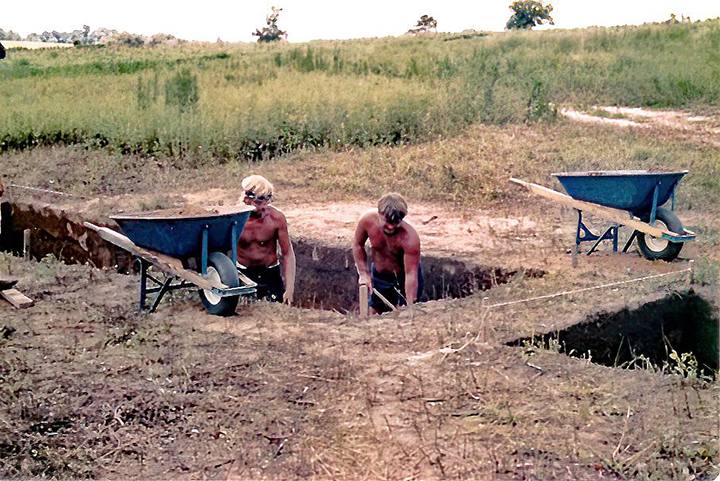James Michael Wisenbaker
Contributor
This is the final article in a series taken from Wisenbaker's memoirs about his time working on an archaeological dig at Hutto Pond, in Madison.
Initially, the whole crew worked at the site for four weeks in July. We found a wide variety and range of artifacts, both in terms of periods and types. So FDOT and FDAHRM extended our work plan, Sans Brown and Moore, for another three weeks in August. During our time at Hutto Pond, the crew established strong bonds and friendships and learned a tremendous amount about practical field archaeology and camaraderie.
Perhaps being a half-century removed from that experience helped to enhance our fond recollections of it. As British archaeologist, Sir Mortimer Wheeler, once said, "Adventure is remembered in tranquility, devoid of the ills and anxieties, fleas (gnats and flies in our case), fevers, thirst and toothaches, which are liable to be the more insistent experience."
Many of us also experienced our first dealings with the press during that summer at Hutto Pond. Reporters from the local Madison Enterprise-Recorder newspaper, such as E.B. Browning, were the most frequent and interested. The more widely circulated Valdosta Daily Times and Tallahassee Democrat also paid us visits and authored several articles about our project.
The unique thing about the excavations there, they marked the first and last time I worked on a site that used a mechanical shaker screen to sift the soil on a dig. A lawnmower engine propelled the device. Browning ran the machine and kept track of where and how deep artifacts came from by bagging and labeling them. Although this gadget speeded up our work, it also could be rough on objects –especially pottery sherds. In any event, four of us from that crew, Browning, Penton, Swindell (part-time) and Wisenbaker, went on to have careers as professional archaeologists.
Christa later attended graduate school at the University of Tennessee for a short time. She said, “I hated it, so we left and came back to Tallahassee. I kept an interest in archaeology through my husband, Robert (Bob) Wilson. He was the curator of collections for SEAC (the Southeastern Archaeological Center) in the National Park Service. We were married for almost 45 years.” Bob passed away in the spring of 2019. He was yet another one of my good friends in graduate school at Florida State.
Brent Mabry eventually vied for a city commissioner seat in Apalachicola and worked as a teacher in Franklin County and continues to be involved in the day-to-day affairs of that historic town. Jackie Moore (1988), Bill Browning (1993) and David Swindell (2004) have all passed away. I knew Jackie the least well of the crew. She spent a lot of time working with Stan Olsen, the department’s zooarchaeologist, on his comparative bone collection and cutting off rat heads in the biological sciences department.
The saddest loss for me was Browning’s death because I knew him best. We shared space in many undergraduate and graduate classes at FSU. Although, at times, he could be churlish, I liked him a lot. After his wife left him for a Publix bagboy, he lost his joie de vivre (enjoyment of life). Bill had adored his young bride. Once their marriage failed, Browning chained smoked, drowned his sorrows with alcohol and buried himself in science fiction novels. He also loved his cats, especially one named “Lovecraft.”
Nevertheless, a couple of notable milestones occurred during that momentous year. These included Congress passing the 26th Amendment, which lowered the voting age in America from 21 to 18. With the new voting age, we no longer could sing with conviction the lyrics, "old enough for killin' but not for votin’" from Barry McGuire's protest song, “Eve of Destruction.”
In the fall of 1971, Walt Disney World opened in Orlando and forever changed the landscape and tenor of Central Florida. In 1971, a gallon of gas cost 40 cents, and the average U.S. income was $10,600 per year, and the median price of a new home was $25,500. Florida's population stood at just under seven million then, while now it's rapidly approaching 22 million.
From this time period, popular songs such as Rod Stewart's “Maggie May” and Paul and Linda McCartney's "Uncle Albert" still stoke cherished memories of that summer in the field, where from 200 to 10,000 years earlier, Native Americans flocked there like moths to a light. Today, thousands of vehicles each day race over the Hutto Pond site on I-10, oblivious to the momentous events that have occurred there for over ten millennia.
More than 44 years after that excavation happened, an opportunity arose to complete the analysis of artifacts from Hutto Pond by Louis Tesar and author a final report by Tesar and me about this highly relevant but long-neglected archaeological site. This fateful turn of events arose because the state promoted me to an archaeological supervisor for the Florida Public Lands Archaeology Program in 2011. My manager, former State Archaeologist, and Chief of the Bureau of Archaeological Research, Dr. Mary Glowacki, graciously and judiciously provided me with the time and funding necessary to complete the long-awaited Hutto Pond report.

